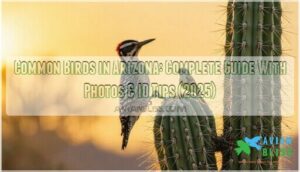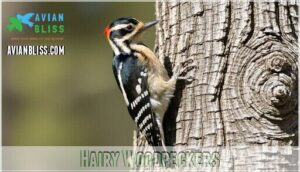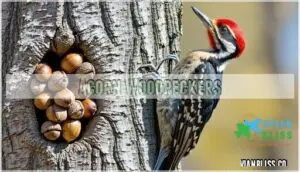This site is supported by our readers. We may earn a commission, at no cost to you, if you purchase through links.

House finches and mourning doves frequent backyard feeders year-round.
The desert brings unique species like Gila woodpeckers that nest in saguaro cacti and tiny verdins building their thorny homes in mesquite trees.
Canyon towhees scratch through leaf litter while American robins hunt for worms in your lawn.
Downy woodpeckers tap on tree bark, and colorful lesser goldfinches visit seed feeders.
Northern cardinals add bright red flashes to desert landscapes.
Arizona’s mix of desert and urban habitats creates perfect conditions for diverse bird populations.
Understanding their feeding patterns and nesting preferences makes identification much easier.
Table Of Contents
- Key Takeaways
- Arizona’s Desert Bird Species
- Common Backyard Birds in Arizona
- Bird Identification and Characteristics
- Woodpecker Comparisons in Arizona
- Migration Patterns of Arizona Birds
- Attracting Birds to Your Arizona Backyard
- Birds of Prey in Arizona
- Arizona’s Most Colorful Bird Species
- Unique Bird Behaviors in Arizona
- Rare and Uncommon Birds in Arizona
- Frequently Asked Questions (FAQs)
- What are the most common birds in Arizona?
- Where can I find birds in Arizona?
- What is the biggest bird in Arizona?
- Are there finches in Arizona?
- What is the main bird in Arizona?
- How do I identify a bird in my backyard?
- What is the small GREY bird in Arizona?
- What is the most commonly seen bird?
- What birds are native to Arizona?
- What are the most common backyard birds in Arizona?
- Conclusion
Key Takeaways
- You’ll spot Arizona’s most common birds right in your backyard – Mourning Doves appear at 47% of sites, House Finches at 46%, and Gila Woodpeckers nest in saguaro cacti year-round.
- Desert-adapted species like Verdins, Canyon Towhees, and Cactus Wrens thrive in Arizona’s harsh conditions through specialized behaviors like water conservation and unique nesting strategies.
- You can attract more birds by providing fresh water daily, native plants, and appropriate feeders in shaded areas – essential strategies for Arizona’s hot, dry climate.
- Learning key identification features like size, color patterns, bill shapes, and feeding behaviors helps you distinguish between similar species like Lesser Goldfinches and American Goldfinches.
Arizona’s Desert Bird Species
You’ll find Arizona’s desert regions home to specially adapted birds that thrive in hot, dry conditions with limited water sources.
These hardy species include the gray-brown Mourning Dove, the zebra-striped Gila Woodpecker, the yellow-headed Verdin, and the ground-dwelling Canyon Towhee.
Arizona’s desert birds showcase nature’s incredible adaptations, thriving where few species dare to venture.
Mourning Doves
When you hear that soft, melancholy cooing echoing across Arizona’s desert landscape, you’re listening to one of the state’s most beloved residents. Mourning doves are among the most common Arizona birds, appearing at 47% of birding sites statewide.
These gentle gray-brown birds measure about 12 inches long with distinctive long tails and small heads. Mourning dove diet consists almost entirely of seeds, which they collect from the ground using their small beaks.
You’ll often spot them at bird feeders or foraging beneath mesquite trees. Their dove nesting habits involve building flimsy stick platforms in trees or shrubs.
Dove vocalizations include their signature mournful call that gives them their name. Despite hunting pressure, their dove conservation status remains stable across North America, making mourning dove identification essential for Arizona bird identification enthusiasts.
Gila Woodpeckers
You’ll spot Gila Woodpeckers throughout arizona bird habitats, especially in Sonoran Ecosystem areas.
These common arizona birds showcase remarkable Desert Adaptation skills, thriving where others struggle.
Their Diet Specialization includes insects, cactus fruits, and nectar, supporting arizona bird identification efforts.
Key Gila woodpecker features:
- Zebra-striped back with grayish-brown body
- Males display bright red cap patches
- Excavate Nesting Habits in saguaro cacti
- Measure 10-12 inches with sturdy bills
- Conservation Status remains stable across Arizona
Verdins
While Gila Woodpeckers command attention with their drumming, Verdins bring subtle charm to Arizona’s desert landscape.
These tiny yellow-headed birds showcase remarkable desert adaptation, thriving in harsh Sonoran conditions where few species survive.
Verdin habitat centers around thorny desert shrubs. Their foraging behavior targets insects and plant nectar.
Here’s what defines Arizona’s smallest desert birds:
- Social Structure: Pairs maintain year-round territories
- Desert Adaptation: Efficient water conservation through specialized kidneys
- Conservation Status: Stable populations throughout range
Canyon Towhees
Canyon Towhees thrive in Arizona’s scrubby Canyon Towhee Habitat across desert foothills and rocky canyons.
You’ll recognize their distinctive "chili-chili-chili" Towhee Vocalizations echoing through the landscape.
Their Towhee Diet consists mainly of seeds and insects found while ground-foraging.
Towhee Behavior includes nest-building in cacti or low trees.
Despite Towhee Conservation challenges from habitat loss, these resilient Arizona bird species continue adapting to changing environments.
Chili-chili-chili"
Common Backyard Birds in Arizona
You’ll spot four main backyard birds throughout Arizona: House Finches with their reddish faces, American Robins showing rusty red breasts, small black-and-white Downy Woodpeckers, and bright yellow American Goldfinches.
These common species visit feeders regularly and adapt well to residential areas across the state’s varied elevations, making them a familiar sight.
House Finches
House finches bring vibrant energy to Arizona backyards with their cheerful songs and social nature.
These common species adapt well to urban environments, making them easy targets for bird identification enthusiasts. You can find a specialized feeder design to attract them.
- Finch Habitats: Thrive in residential areas, parks, and desert edges
- Finch Diets: Primarily seeds from feeders, native plants, and fruits
- Finch Sounds: Males produce continuous warbling melodies year-round
American Robins
American Robins visit Arizona backyards regularly during winter months, making them easy to spot among common species.
You’ll recognize their rusty red breast and dark head for bird identification. Their robin diet includes berries and insects found in diverse bird habitats.
Listen for their distinctive robin song signaling seasonal changes. Robin nesting occurs in spring using mud-lined structures, while robin migration patterns bring them south during colder months.
Consider providing specialized feeding options to attract them.
Downy Woodpeckers
Downy Woodpeckers are Arizona’s tiniest woodpeckers, measuring just 6-7 inches.
You’ll spot their black-and-white striped backs and short bills at backyard feeders.
Males display red patches on their heads, while identifying females is easier—they lack the red coloring.
Their downy diet includes insects, seeds, and suet.
For supplemental feeding, consider a specialized suet feeder.
Habitat preferences include oak woodlands and riparian areas.
Listen for their sharp "pik" calls.
Nesting habits involve excavating cavities in dead wood during spring breeding season.
American Goldfinches
These bright yellow beauties bring sunshine to Arizona bird watching adventures year-round.
American Goldfinch males showcase brilliant plumage variation during breeding season, while females display subtle brown tones.
Their distinctive song characteristics include sweet warbling calls and flight patterns.
- Goldfinch diet: Nyjer, sunflower seeds, and native plant seeds
- Plumage variation: Males bright yellow, females brownish-gray
- Song characteristics: Musical trills and sweet "po-ta-to-chip" calls
- Nesting habits: Late summer breeding in shrubs and trees
- Attracting goldfinches: Tube feeders with fresh Nyjer seeds work best
Bird Identification and Characteristics
You can identify Arizona’s common birds by examining their size, color patterns, and feeding behaviors.
Learning to recognize key features like wing bars, tail shapes, and bill types will help you distinguish between species like Lesser Goldfinches and Spotted Towhees in your backyard, using complete concepts to guide your identification.
Lesser Goldfinches
With their bright yellow underparts and contrasting dark wings, Lesser Goldfinches bring vibrant color to Arizona’s diverse landscapes.
You’ll spot these small songbirds in almost any habitat across the state, from desert washes to mountain canyons.
Their Goldfinch Diet consists primarily of seeds from thistles, sunflowers, and native plants.
During Goldfinch Molting season, males may appear duller as they shift between breeding plumages.
Listen for their complex Goldfinch Songs – a delightful mix of warbles and trills that enhance any Arizona bird watching experience.
For Goldfinch Nesting, they prefer shrubs and small trees.
Their adaptable Goldfinch Habitat makes them one of Arizona’s most reliable bird species for birdwatching enthusiasts year-round.
Yellow, black
Distinctive, cheerful calls
Spotted Towhees
Anyone exploring Arizona bird species will find Spotted Towhees scratching through leaf litter with distinctive backward kicks.
These Arizona birds prefer brushy undergrowth where their rufous sides and white-spotted wings flash among vegetation.
- Spotted Towhee Habitat: Dense shrublands and woodland edges
- Towhee Vocalizations: Clear "drink-your-tea" songs echo through canyons
- Towhee Diet: Ground-foraging for insects, seeds, and berries
- Towhee Nesting: Hidden cup nests in low shrubs
Bewick’s Wrens
Bewick’s Wrens bring music to Arizona’s brushy landscapes with their distinctive three-to-five phrase songs.
You’ll recognize these small Arizona birds by their long tails held upright and striking white eyebrows. Identifying Bewick’s involves noting their slender, downcurved bills and energetic hopping through dense vegetation.
Their Bewick’s Habitat includes dry, scrubby areas where Wren Behavior showcases their bold personalities. Conservation Status remains stable, making them reliable finds for Arizona bird watching enthusiasts seeking common birds with powerful voices.
| Feature | Description | Field Mark |
|---|---|---|
| Size | Smaller than House Sparrow | Compact body |
| Tail | Long and upright | Distinctive posture |
| Song | 3-5 musical phrases | Loud and clear |
Say’s Phoebes
Say’s Phoebes stand out among Arizona bird species with their cinnamon-buff bellies and brownish-gray backs.
You’ll spot these arizona native birds perched on fence posts, scanning for flying insects. Their distinctive "pee-ur" call helps with Phoebe identification during arizona bird watching.
Key Say’s Phoebe characteristics:
- Habitat: Open desert areas, farmlands, and rocky outcrops
- Nesting habits: Build mud nests under eaves, bridges, or cliff ledges
- Diet: Flies, beetles, and other aerial insects caught mid-flight
Woodpecker Comparisons in Arizona
You’ll find several woodpecker species in Arizona, each with distinct features that make identification straightforward once you know what to look for.
The Gila Woodpecker’s black and white zebra pattern and the Downy Woodpecker’s smaller size help distinguish them from the larger Hairy Woodpecker and the unique Acorn Woodpecker with its clown-like face markings.
Hairy Woodpeckers
Hairy Woodpeckers stand out among arizona bird species with their bold black and white plumage.
You’ll spot these medium-sized birds in Arizona’s mountain forests and wooded canyons.
Their longer bills distinguish them from similar species like the Gila Woodpecker.
| Feature | Description |
|---|---|
| Size | 7-10 inches with sturdy build |
| Hairy habitat | Mature forests, oak woodlands |
| Hairy diet | Wood-boring beetles, ants, seeds |
Hairy vocalizations include sharp "peek" calls that echo through trees.
Hairy behavior involves drumming on dead branches to find insects and communicate.
Males show red patches on their heads during breeding season.
Hairy conservation benefits from protecting old-growth forests.
This arizona bird guide helps arizona bird watching enthusiasts identify these striking woodpeckers year-round.
Acorn Woodpeckers
You’ll spot Acorn Woodpeckers living in tight-knit family groups throughout Arizona’s oak woodlands.
Their Social Behavior revolves around creating massive Acorn Granaries – drilling thousands of holes in trees to store acorns.
These backyard birds arizona enthusiasts should know about their Acorn Dependence and specific Habitat Preferences for oak-rich areas.
These woodpeckers exhibit clever foraging strategies to secure their food supply.
| Feature | Acorn Woodpecker | Gila Woodpecker | Comparison |
|---|---|---|---|
| Storage Behavior | Creates acorn granaries | Caches various foods | Acorns vs. mixed diet |
| Social Structure | Lives in family groups | Mostly solitary pairs | Communal vs. independent |
| Habitat Preferences | Oak woodlands | Desert riparian areas | Trees vs. cacti |
| Conservation Status | Stable populations | Declining in some areas | Secure vs. threatened |
| Arizona Distribution | Mountain regions | Sonoran Desert | Elevation-dependent ranges |
Migration Patterns of Arizona Birds
Understanding Arizona bird migration reveals fascinating patterns shaped by elevation changes and seasonal rhythms. Arizona migratory birds follow complex routes determined by climate impacts and available stopover habitats. Bald eagles move northward after breeding season, while many species shift between mountain and desert regions based on temperature and food availability.
Bird migration in Arizona involves both long-distance travelers and altitude migrants. Some birds winter in southern Arizona’s warm valleys, then move to cooler mountains for breeding. Others pass through as part of continental migration patterns. Migratory triggers include daylight changes, temperature shifts, and food scarcity.
Arizona bird migration creates remarkable birdwatching opportunities:
- Spring arrivals bring vibrant warblers and colorful migrants
- Fall departures offer chances to spot rare passage birds
- Winter visitors transform desert landscapes with northern species
- Year-round residents mix with seasonal newcomers
- Mountain movements provide dramatic elevation-based migrations
Conservation challenges include habitat loss and climate change affecting traditional migration patterns. Seasonal movements depend on maintaining critical stopover habitats throughout the state’s diverse ecosystems. The state identifies focal migratory species to prioritize conservation efforts.
Attracting Birds to Your Arizona Backyard
You can transform your Arizona backyard into a bird haven by providing water sources, native plants, and appropriate feeders that attract species like House Finches, Mourning Doves, and Gila Woodpeckers.
The desert climate requires specific strategies such as placing feeders in shaded areas and offering fresh water daily to successfully draw in Arizona’s common bird species, including House Finches and Mourning Doves.
Northern Cardinals
Northern Cardinals add year-round color to Arizona backyards despite preferring eastern habitats.
These common birds thrive near bird feeders stocked with sunflower seeds.
Cardinal nesting requires dense shrubs for protection.
You’ll recognize their distinctive cardinal songs echoing through neighborhoods.
To further encourage their presence, consider creating diverse habitats with varied plant life.
Plant native vegetation and maintain consistent food sources to support cardinal conservation efforts while enjoying Arizona’s vibrant birdwatching opportunities.
Hummingbirds
Arizona’s hummingbirds offer year-round backyard magic through their Iridescent Plumage and essential Pollination Role.
Anna’s Hummingbird, Black-chinned Hummingbird, and Rufous Hummingbird visit reliable Nectar Sources during Hummingbird Migration periods.
Attracting these birds requires specific strategies.
- Bright red feeders catch their attention instantly
- Sugar-water nectar provides essential energy for flight
- Native desert plants create natural feeding stations
- Clean water sources support their daily needs
- Protected perching spots offer safety from predators, which is crucial for their survival and overall well-being during Hummingbird Migration.
Birds of Prey in Arizona
Arizona’s diverse landscapes support numerous birds of prey, from the ground-running Greater Roadrunner to soaring hawks and ravens that patrol the desert skies.
Arizona’s desert skies showcase nature’s most magnificent aerial predators in action.
You’ll find these skilled hunters in various habitats across the state, where they play important roles in controlling rodent populations and maintaining ecological balance.
Greater Roadrunners
Despite their cartoonish reputation, Greater Roadrunners are serious desert predators in Arizona’s Sonoran Desert.
These rattlesnake hunters use speed and cunning to catch prey across desert terrain.
You’ll recognize their roadrunner behavior through low-pitched cooing calls and ground-running hunting style across Arizona’s arid landscapes.
| Feature | Description |
|---|---|
| Diet | Lizards, snakes, insects |
| Footprints | Distinctive X-shaped tracks |
| Adaptations | Heat tolerance, water conservation |
American Crows
Among Arizona’s most intelligent common birds, American Crows showcase remarkable problem-solving abilities that’ll amaze any birdwatching enthusiast.
These adaptable black birds thrive across diverse habitats throughout Arizona.
Here’s what makes them special:
- Crow Intelligence: Uses tools and remembers human faces for years
- Crow Communication: Complex calls convey specific warnings and information
- Crow Diet: Omnivorous scavengers eating insects, seeds, small animals
- Crow Habitat: Urban areas, farmlands, and desert edges statewide
Ravens
Through their raven intelligence and complex bird behavior, Common Ravens stand out as Arizona’s most fascinating corvids.
You’ll spot these all-black birds displaying remarkable raven behavior like tool use and problem-solving across diverse raven habitats from deserts to mountains.
Their omnivorous bird diets include carrion, insects, and small animals, while raven symbolism appears throughout Native American cultures statewide.
Hawks and Eagles
Soaring predators dominate Arizona’s skies, showcasing impressive hunting techniques across diverse raptor habitats.
You’ll spot these magnificent birds of prey arizona residents know well, from desert valleys to mountain peaks.
- Red-tailed Hawk – Most common raptor with distinctive rusty tail feathers
- Harris’s Hawk – Desert specialist known for cooperative hunting behaviors
- Cooper’s Hawk – Agile woodland hunter with rounded wings and long tail
- Osprey – Fish-eating specialist found near permanent water sources
- Golden Eagle – Massive mountain dweller requiring conservation status monitoring
Hawk migration patterns vary by species, while eagle identification relies on size and habitat preferences.
Arizona’s Most Colorful Bird Species
You’ll find some of Arizona’s most vibrant birds display brilliant reds, blues, and yellows that stand out against the desert landscape.
These colorful species include the fiery red Vermilion Flycatcher, sky-blue Mountain Bluebird, and the striking blue-and-rust Western Bluebird that add natural beauty to your birdwatching experience.
Vermilion Flycatchers
You’ll spot Vermilion Flycatchers perched on fence posts throughout Arizona’s desert landscapes.
Males display brilliant scarlet-red plumage while females show brownish colors with peachy undersides.
These common birds use perch hunting to catch insects mid-flight, making them fascinating for birdwatching enthusiasts.
Listen for their distinctive chirpy song as they dart after prey with remarkable precision and agility.
Western Bluebirds
While the Vermilion Flycatcher dazzles with its red flames, the Western Bluebird brings a different kind of magic to Arizona’s colorful bird species.
You’ll spot these stunning birds across the state, where males showcase vibrant blue backs with rusty orange chests. Females wear more subdued gray-brown tones with subtle blue highlights.
Western Bluebirds face challenges from habitat loss and competition for nesting sites. Their diet preferences shift seasonally – insects dominate summer meals while berries sustain them through winter.
Understanding their nesting habits helps with birdwatching success.
Color variations between sexes make identification easier on your arizona bird checklist:
- Males display deep blue upperparts with orange-red breast patches
- Females show brownish-gray coloring with blue wing and tail tinges
- Both sexes have white bellies and dark bills
- Juveniles resemble females but appear more spotted
- Breeding males develop brighter, more intense blue coloration
Mountain Bluebirds
You’ll spot Mountain Bluebirds in Arizona’s high-elevation areas, where males display brilliant sky-blue plumage while females show gray-brown coloring with blue highlights.
Their nesting habits include using tree cavities and nest boxes. Diet variation includes aerial insect hunting and berry consumption. Skilled aerial hunters are adept at catching insects mid-flight.
Conservation status remains stable, but protecting their mountain meadow homes supports Arizona bird diversity. These arizona bird species face habitat loss from development, making birdwatching opportunities precious.
Unique Bird Behaviors in Arizona
Arizona’s bird diversity creates fascinating behavior patterns you won’t see anywhere else.
Nesting habits here are remarkable – Cactus Wrens build multiple decoy nests in cholla cacti to confuse predators, while Gila Woodpeckers excavate holes in saguaros that become prime real estate for other species.
Mating rituals showcase incredible adaptations. Curve-billed Thrashers perform elaborate songs from desert shrubs, and Gambel’s Quail males strut with distinctive head plumes during courtship displays.
Foraging strategies reveal clever survival tactics. Verdins hang upside-down from branches to reach insects, while Greater Roadrunners use their speed to chase lizards across open desert terrain.
Social interactions vary dramatically. Anna’s Hummingbirds aggressively defend territory around feeders, but House Finches travel in large, peaceful flocks. Predator avoidance techniques include the Mourning Dove’s explosive takeoff that startles potential threats. Smaller birds may also engage in mobbing behavior to drive away predators.
These bird adaptations demonstrate how common birds thrive in Arizona’s challenging environment through specialized behaviors perfectly suited to desert life.
Rare and Uncommon Birds in Arizona
While you’ve spotted common birds around Arizona, you’ll encounter several species that appear less frequently but still call the state home.
These uncommon birds include Common Ravens, Brown-headed Cowbirds, European Starlings, and Great-tailed Grackles, which you can find in specific habitats and seasons throughout Arizona’s diverse landscapes.
Common Ravens
You’ll find common ravens among Arizona’s most fascinating birdwatching discoveries.
These brilliant problem-solvers showcase incredible raven intelligence through complex social behaviors and tool use. Their omnivorous raven diet includes everything from carrion to insects, adapting perfectly to diverse raven habitat across the state’s landscapes.
Key identifying features include:
- Massive 21-26 inch wingspan with iridescent black plumage
- Deep, guttural raven calls distinguish them from smaller crows
- Wedge-shaped tail visible during flight
- Found in wooded areas and arizona birdwatching destinations
Brown-headed Cowbirds
Brown-headed Cowbirds practice brood parasitism, sneaking eggs into over 220 host species’ nests across Arizona’s expanding range.
You’ll spot these crafty birds following cattle in open fields.
Their impact on arizona bird species list creates serious conservation concerns.
Watch for males’ chocolate-brown heads and females’ streaky gray plumage. Listen for their distinctive liquid gurgling calls during bird behavior patterns observations.
European Starlings
European starlings remain uncommon across Arizona’s diverse landscapes, though these invasive species occasionally appear in urban areas.
Understanding starling identification helps distinguish them from similar bird species during birdwatching adventures.
Key features include:
- Glossy black plumage with iridescent green and purple sheens that shimmer in sunlight
- Sharp yellow bills contrasting against dark feathers, unlike house sparrow beaks
- Aggressive starling behavior when competing for nesting sites and food sources
Great-tailed Grackles
Unlike European Starlings, Great-tailed Grackles (Quiscalus mexicanus) showcase stunning iridescent plumage across Arizona.
You’ll spot these arizona bird species list favorites in urban parks and agricultural areas.
Their Grackle Vocalizations include harsh calls and whistles.
Grackle Diet consists of insects, seeds, and small animals.
Grackle Behavior involves flocking together, while their Grackle Range extends throughout the state.
These common birds in arizona adapt well to human environments.
Frequently Asked Questions (FAQs)
What are the most common birds in Arizona?
Arizona’s skies dance with feathered residents year-round.
You’ll spot Mourning Doves most frequently at 47%, followed by House Finches at 46%.
Gila Woodpeckers, Lesser Goldfinches, and Verdins also grace the desert landscape regularly.
Where can I find birds in Arizona?
You’ll spot birds throughout Arizona’s diverse landscapes, from desert parks like Red Rock and Dead Horse Ranch to mountain canyons.
Visit Patagonia Lake, explore wooded river areas, and check urban neighborhoods where many species thrive year-round, especially in areas with diverse landscapes.
What is the biggest bird in Arizona?
Think massive doesn’t mean rare – you’ll spot Common Ravens everywhere across Arizona.
These impressive black birds stretch 21-26 inches long and weigh up to 5 pounds, making them the state’s largest commonly seen species.
Are there finches in Arizona?
Yes, you’ll find finches thriving throughout Arizona.
House Finches are extremely common, visiting 90% of sites with reddish faces and urban preferences.
Lesser Goldfinches also flourish here, displaying bright yellow underparts in diverse habitats.
What is the main bird in Arizona?
The Mourning Dove takes the crown as Arizona’s most common bird, appearing at nearly half of all birding sites.
You’ll spot these gentle, gray-brown birds almost everywhere across the state’s diverse landscapes, with the Mourning Dove being a key species to look out for.
How do I identify a bird in my backyard?
Look closely at your bird’s size, colors, and markings.
Notice its beak shape, tail length, and behavior patterns.
Use a field guide or birding app to match these features and confirm your identification.
What is the small GREY bird in Arizona?
You’re likely spotting a Verdin.
It’s a tiny, grayish bird with a bright yellow head, common in Arizona’s deserts.
They love flitting around shrubs and trees, often building large, messy nests.
What is the most commonly seen bird?
You’ll spot the Mourning Dove most frequently in Arizona, appearing at 47% of birding locations. These light gray-brown birds with their distinctive cooing calls thrive in open habitats throughout the state.
What birds are native to Arizona?
Arizona’s avian tapestry weaves together stunning native species you’ll discover across diverse habitats.
The Cactus Wren, your official state bird, thrives in Sonoran Desert alongside Gila Woodpeckers, Verdins, and Curve-billed Thrashers perfectly adapted to desert life.
What are the most common backyard birds in Arizona?
You’ll frequently see House Finches, Mourning Doves, and Gila Woodpeckers at your feeders.
White-winged Doves, Curve-billed Thrashers, and Verdins also visit regularly.
These desert-adapted species thrive in Arizona’s unique backyard environments year-round, making them a year-round presence.
Conclusion
Spotting common birds in Arizona becomes second nature once you know what to look for.
You’ll quickly recognize mourning doves cooing at dawn and Gila woodpeckers drumming on saguaros.
House finches will visit your feeders daily while verdins build their spiky nests nearby.
Keep your binoculars ready and field guide handy.
Arizona’s diverse habitats support year-round residents and seasonal visitors alike.
Start with these species, and you’ll soon identify dozens more feathered neighbors sharing your desert home.
- https://tucsonbirds.org/wp-content/uploads/2022/01/TAS-VEFL-Winter2022-WEB.pdf?ref=tas
- https://phys.org/news/2019-03-phoenix-birds-homeowners-habitat-species.html
- https://www.aphis.usda.gov/sites/default/files/az-2022-birddamagemgt-final-ea.pdf
- https://aziba.org/wp-content/uploads/2018/03/TAS_IBA_Grasslands_web_higer-res.pdf
- https://www.nps.gov/orpi/learn/nature/birds.htm
















